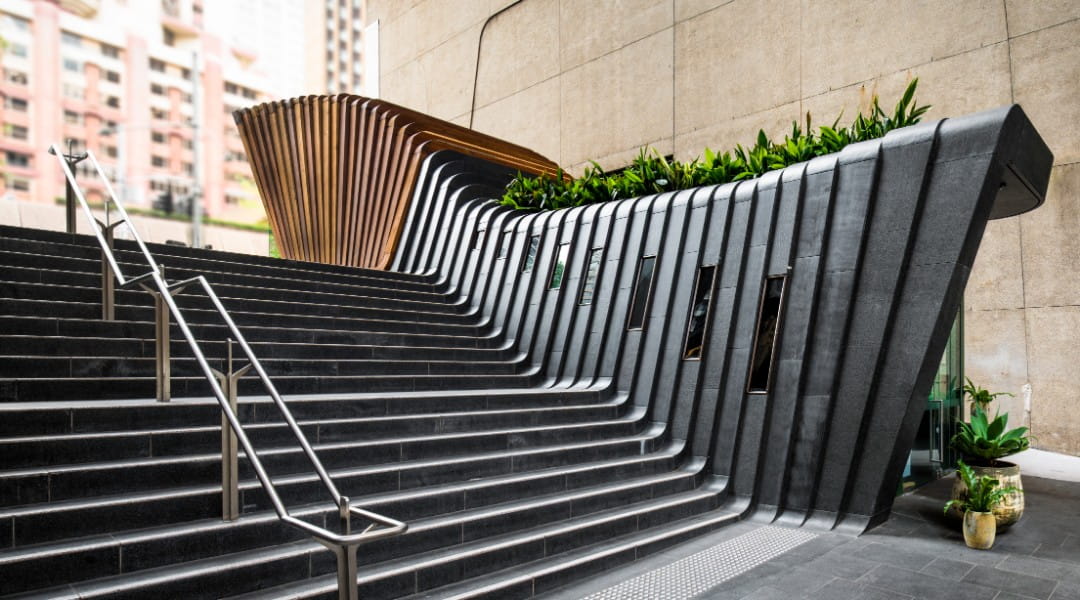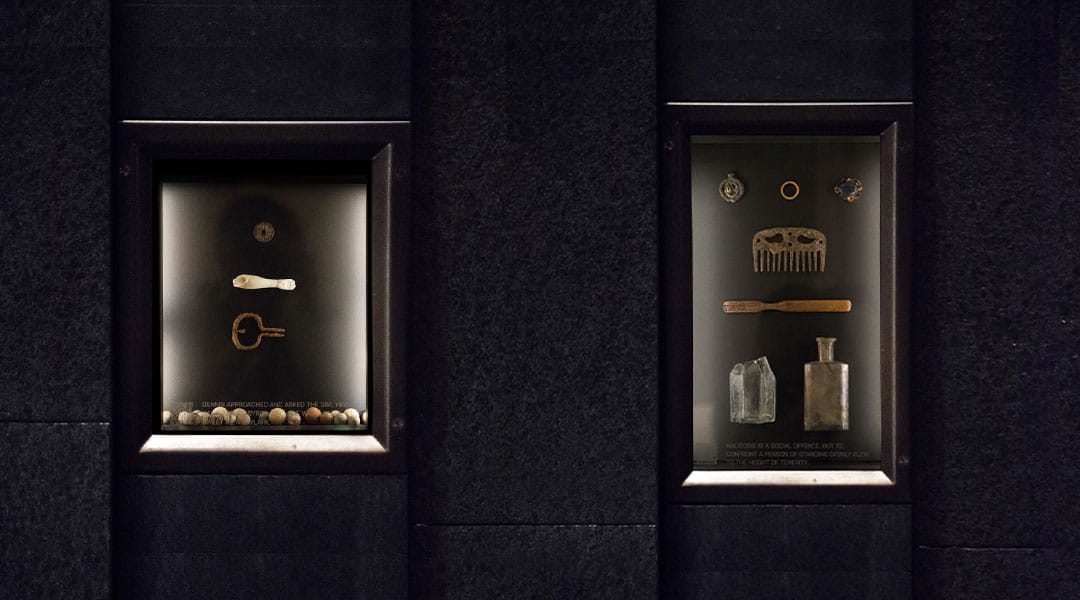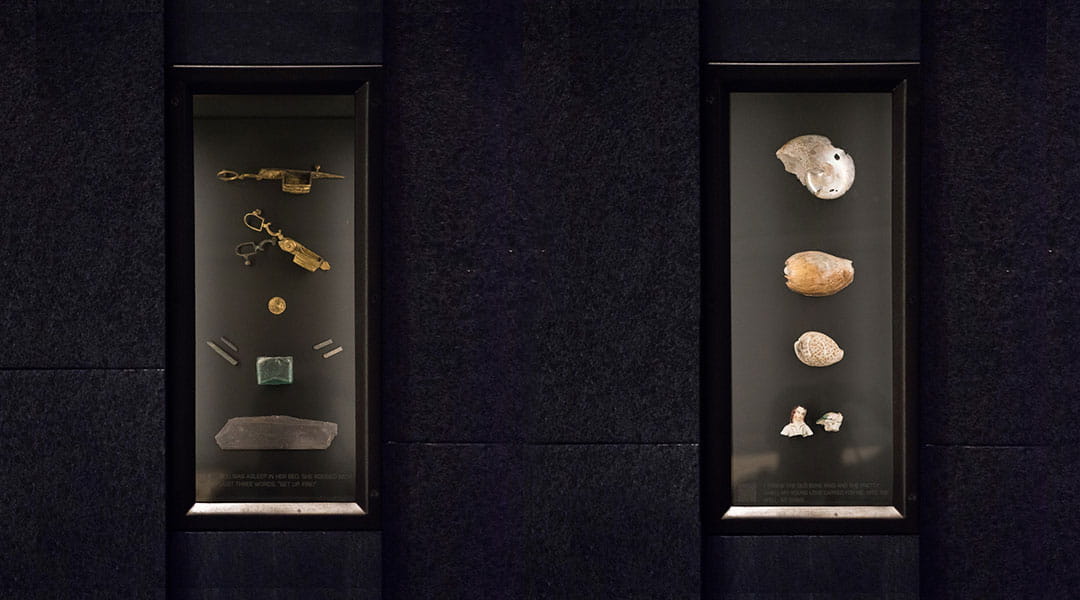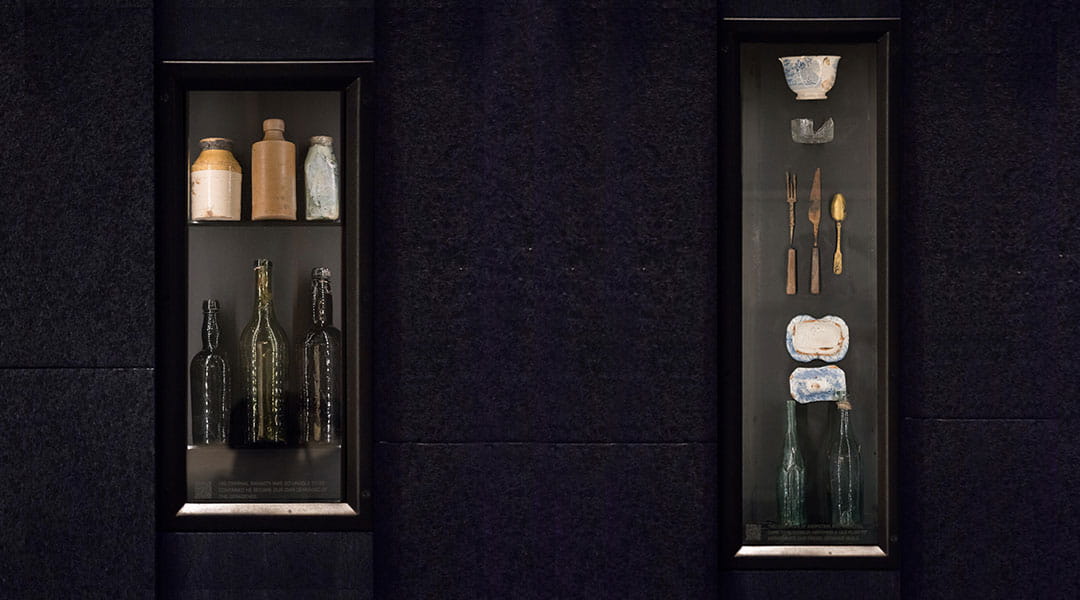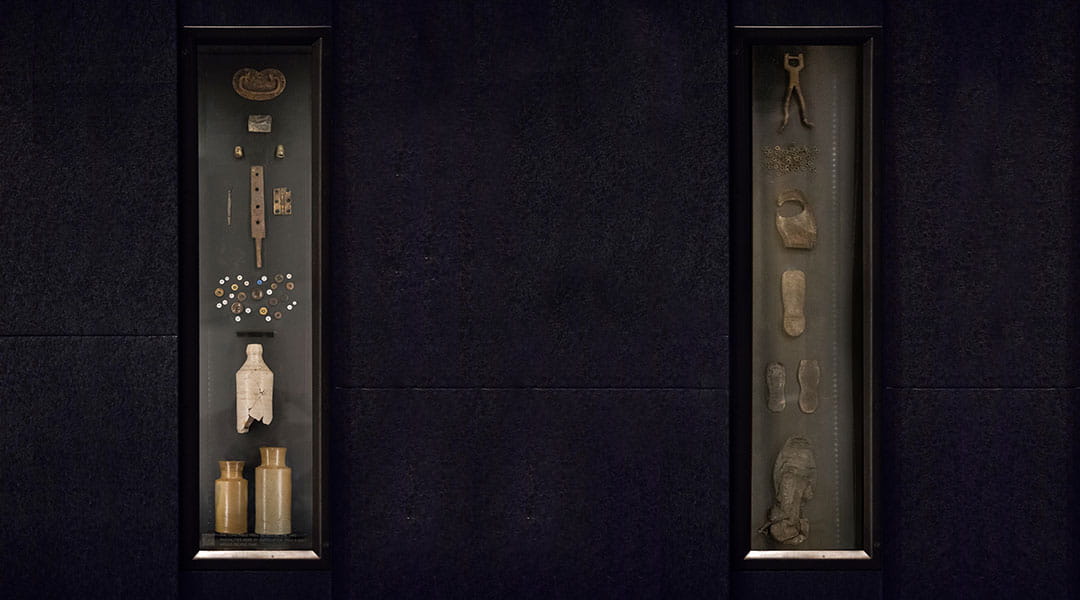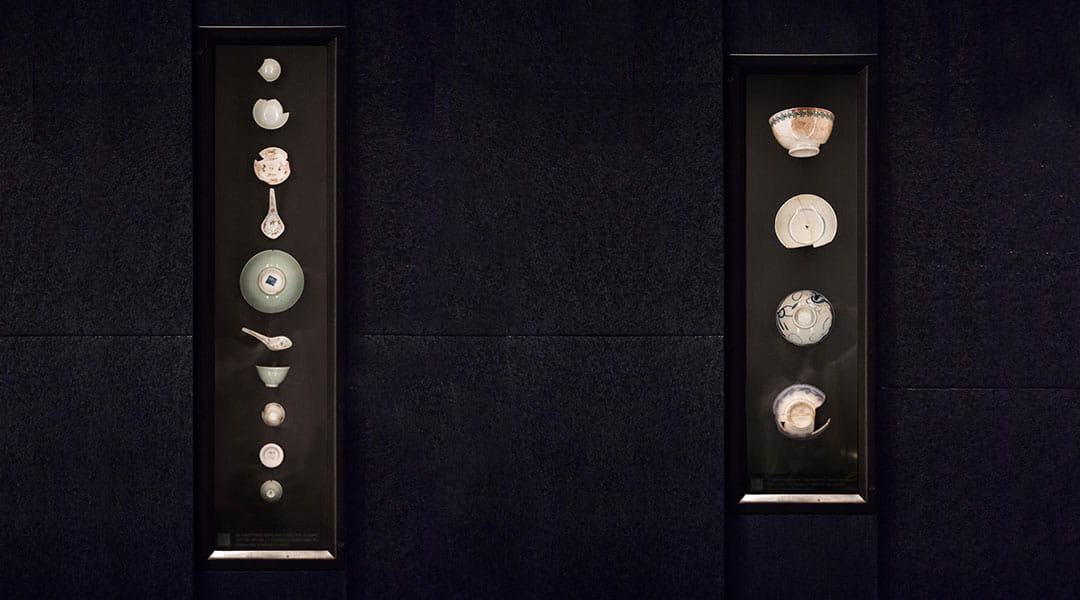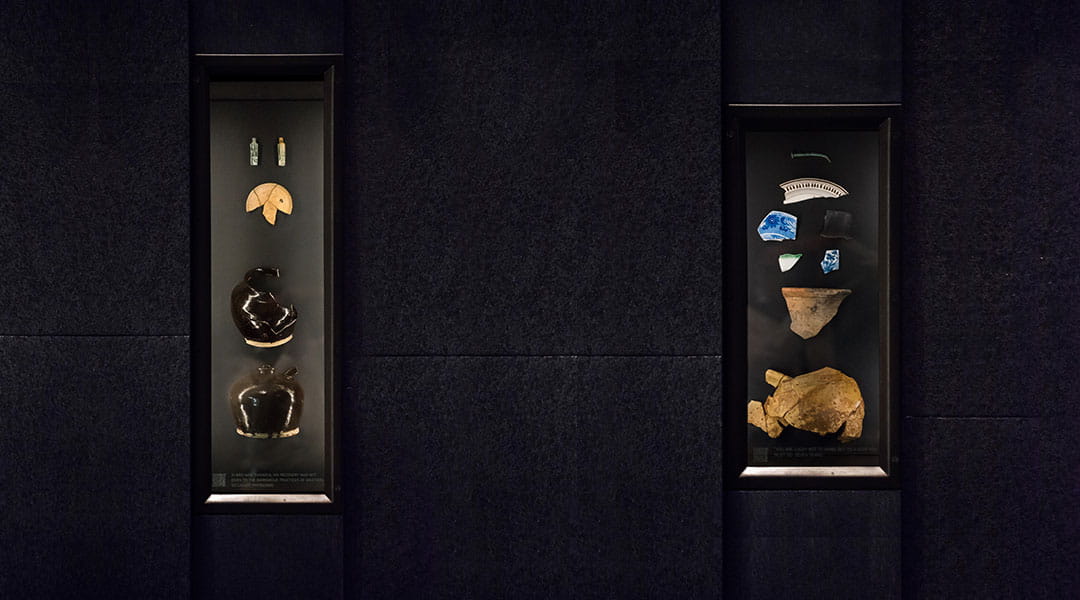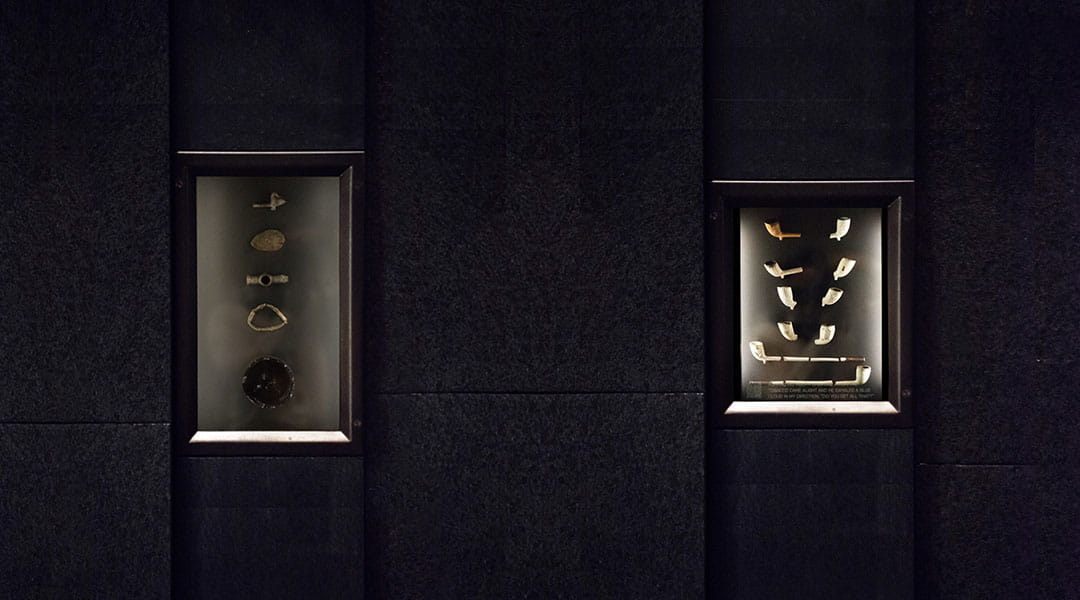.jpg?h=1080&w=1920&hash=F649B18CAC25BC81D7ECCB48268F9825)
Bringing history to life
EY Centre’s site was one of the first areas settled by Europeans following colonisation in 1788, and its design celebrates this rich heritage.
For EY Centre, 200 George Street, Mirvac set out to develop a landmark commercial building for leading organisations. The integrated office tower was designed to be organic and responsive to its surrounds, adding value for the community. Mirvac worked with a team of experts to preserve, record and celebrate the site’s rich heritage, including the sensitive recovery of over 23,700 artefacts during the excavation process. These artefacts have been adaptively reused throughout the ground plane of the building, artistically showcasing the steeped history of area.
-
READ MORE
GML Heritage was appointed to undertake an archaeological investigation as part of the redevelopment, which began during demolition and before the excavation of the carpark.
During the 12-week excavation, the archaeologists uncovered over 23,700 artefacts that related to Sydney’s colonial and Victorian era history. Excavation in the basement of the EY Centre, 200 George Street site uncovered the original topography of the bedrock, stepping down to the Tank Stream. Many features had been cut into the bedrock, including two large wells that were approximately 2.5 metres deep and 1.6 metres wide and brimming with interesting artefacts. Among the artefacts were leather shoes and offcuts, buttons, pins, candle-wick scissors, coins, clay pipes and jewellery. Unusual tobacco pipes found at 200 George Street have commemorative images, such as the Crystal Palace and portraits of Queen Victoria and Prince Albert.
The most significant and interesting artefacts have been integrated within the public domain at EY Centre, 200 George Street, displayed in illuminated boxes with QR codes that link to additional information online. The website also presents a series of fictional stories commissioned by Mirvac inspired by the artefacts. In addition to this, historical images are presented on panels of the adjacent Underwood Street façade of 4 Dalley Street, which trace the history of the site from Aboriginal history through to modern times. Further, a bronze inlay has been cast into the floor and weaves through the ground floor lobby and public domain to represent the location of the harbour foreshore line in the late 18th Century.
Case 1 - Four Seasons Four Flowers
The decorations on these Chinese-produced ceramics were used on a range of bowls, cups, spoons and dishes. The patterns contain characters and symbols that are centuries old. Over time, the patterns sometimes changed, such as the characters on the base of the bowls. Typically, such markings stated the reigning emperor and year made. Yet the information is not clear on these bowls.
Flowers had a range of meanings. The four seasons, four flowers pattern includes one flower for each season—peony for spring, lotus for summer, chrysanthemum for winter and plum blossom for winter. They are placed around a central image of a peach, which symbolises longevity. As well as representing the seasons, these flowers have other symbolic and auspicious meanings. The peony is the ‘king of the flowers’ and stands for wealth and honour. The lotus is a symbol of purity, harmony and wealth. The chrysanthemum and plum blossom represent perseverance and purity, and are also symbols of longevity.
The colour of Winter Green (which looks like jade) is associated with Jun Zi—a well-educated Chinese man with the highest moral virtues. The colour was also associated with heaven and the colour of the clear sky after rain.
Case 2 – No Place Like Home
A well in the yard of Ah Toy’s cabinet factory contained an unusually high number of bowls produced in both China and Britain. Like many of the Chinese people who immigrated to Australia, these blue min yao (people’s wares) came from southern China. Made for the local market, but exported to Chinese people around the world, they would have either been brought out with immigrants or shipped to Australia by merchants and sold in Chinese-run stores. The abundance of British-made bowls found at 200 George suggests that Chinese-made wares could not always be sourced. So the occupants made do with similar forms made by non-Chinese manufacturers.Rice bowls were the most basic tableware for southern Chinese people. Their diet was primarily rice-based, supplemented with small amounts of meat, fish and vegetables. The high proportion of fish bones and butchered animal bones found in the well suggests these foods were eaten by the Chinese furniture makers and families who were working and living on site.
In family settings, members would have shared meals around a table, each with an individual rice bowl. Each worker in Ah Toy’s factory probably had his own rice bowl too, with lunch often provided by their employer and served out of common cooking pots directly into these bowls.
Case 3 – A Taste of China
Chinese people living at George Street were not without the flavours and comforts of home. Along with a large range of bowls and cups, food and medicine was also imported. The large jars found on site were made in southern China, sealed with stone lids, and then shipped to food-processing factories. The fut how nga (wide-mouthed jar) was used for storing a variety of fermented soybean sauces. The nga hu (shouldered jars with a spout) would carry liquor, soy sauce, vinegar or oil.
Little glass bottles would have contained a single dose of medicine. Once the medicine was consumed the bottle was discarded.
Case 4 – Victorian Style
These objects could have been found on the table of a great number of Victorian households. Hundreds of families lived and worked in the buildings that occupied this site during the nineteenth century. Mrs Ellis, Mr Schweigert, Mr Charles Evans, G Bennis and Mr PB Murphy are just some of the shopkeepers who might have sat down to the table for a meal with these things.
The Brosley pattern on this cup is just one of the many ceramic patterns available to the Victorian consumer in Sydney. Mass produced with a huge range of patterns, full sets of dinnerware were suddenly readily available and priced affordably for households. Some patterns remained in use for decades, and are still in use today.
Steel cutlery was also found. It’s likely that these knives and forks would have been attached to bone handles as shown here, or timber which did not survive.
The bottles would have contained salad oil or vinegar and were intended to sit on the table during the meal. The contents of other items like the small dishes are harder to ascertain. They were perhaps used to store sugar and other staples.Limited evidence of food was recovered during excavations but rock oyster and mud oyster shells were found in great quantities, suggesting that these were a popular meal. Bones recovered indicate a diet of commonly-available cuts of meat, with large quantities of sheep, cow, pig and fowl bones. Some more interesting bones were found including, including three butchered horse hooves!
Case 5 – So Much in Store
Bottles and jars such as these were ubiquitous in the nineteenth century and well into the twentieth. They could be found in private households and public hotels alike. They were used for storage and the sale and transportation of a range of common goods. Dark olive-coloured glass bottles were used for beer and wine. Ginger beer had a very distinct stoneware bottle. The one with bulbous lip and salt glaze is a good example. Other bottles with wide openings could hold pickled foods and chutneys, allowing the contents to be spooned out.
More valuable liquids like medicines needed to be prepared individually and were sold in smaller quantities. Small bottles were generally filled and refilled by druggists as required.
Case 6 – House Proud
Home decoration and display was popular in the past, just as it is today. Shells and figurines typically sat on mantlepieces and fireplaces within Victorian homes. Unlike most of the assemblage, these items have no function other than to decorate and brighten the rooms. Mass produced and reasonably priced, figurines were popular among working people. Strangely only a small number of figurines were identified at the site, such as this badly damaged one of a man who appears to be holding a bird in one hand.
Exotic shells were collected and traded for natural history collections. During the Victorian period this was a popular hobby, and unusual shells, plants or animals were collected and displayed, often as part of a cabinet of curiosities. The shell of a chambered nautilus has been a source of curiosity since the Renaissance. Each chamber is formed by the growing nautilus, before it moves its growing body into the larger space and seals the old one behind it.
Someone painstakingly carved the matte exterior of this shell away to form an elegant and delicate raised floral design. This was commonly done by sailors, producing intricate patterns. More extravagant examples were mounted on stems to form cups and used to decorate homes. This shell was likely to have taken pride of place as part of a family’s natural history collection. It is a rare object of beguiling and captivating beauty.
Case 7 – Candles and Quills
The assortment of household items provide a window into the daily lives of the people who resided here throughout the nineteenth century. The items reveal technologies which have long since been replaced and forgotten.
These candlewick scissors were used to trim wicks, with a small basket provided to collect the offcuts. The vesta box would carry short matches and keep them dry. People regularly needed to light stoves and lanterns, but early matches were unreliable and could be accidentally lit when rubbed together. The small boxes contained the matches, while the ribbed base could be used to light them.
A wide range of writing tools were found, from slate and pencil to an ink bottle for writing with a quill. Pieces of lead, the predecessor of pencils we use today, were also uncovered, suggesting people were literate and valued education.
Case 8 – Combed and Clean Cut
Personal items reveal the care given to hygiene and appearance. Small items of jewellery, such as these pendants and the bone ring, are but a few of such items uncovered. The woman’s metal comb, now corroded, would have been decorated and polished originally.
Oral health was important too. Several bone toothbrushes were found. The complete one here shows the small holes through which bristles were threaded, and the wires used to hold them in place. The bottles would have contained perfumes, or possibly medicines. This broken bottle once contained Johann Marie Farina Eau de Cologne; the oldest perfume in the world (still in production today). Made with citrus oils and herbs like lavender, rosemary and thyme, Farina described it as an ‘Italian spring morning, of mountain daffodils and orange blossoms after the rain’.
Case 9 – All Fun and Games
Children and adults played games for fun and amusement. This small doll’s arm was likely owned by one of the many children who lived here. Marbles were a common toy for children but were also used in board games. The marbles are all ceramic and probably came from Germany. The Germans dominated the marble-making market before World War I. A wide variety of marbles were found. ‘Chinas’ were made of porcelain painted in bands, the pink-swirled ‘aggies’ were clay and made to imitate expensive stone marbles. Most plentiful, were the cheap and readily available ‘commies’; buff-coloured and poor-quality earthenware.
Chinese coins like this couldn’t be used as money in Australia but could be used in fortune telling or as tokens in gambling games such as fantan.
A simple musical instrument like the jaw harp could be played by adults or children. The frame is placed between the players teeth, and the central tongue of flexible metal (missing here) is plucked to create a note.
Case 10 – Stocking Up
A peculiar range of goods were recovered across the site that were made or sold by the many businesses that operated here in the nineteenth century.
The letter ‘s’ pehaps relates to the printers that operated here; first Stephen and Stokes, then the Sydney Morning Herald. Sewing equipment like buttons, needles and cotton reels, and a good deal of fabric was found. In 1880, the Robinson Clothing Factory was established here, with a shop fronting George Street. These objects maybe from a dump of their rubbish. As well as professional seamstresses, it’s also likely that the women who lived here were sewing and mending for their families. It was common for women to take in extra sewing work to supplement the family income.
The origins of other items are less certain. Could the hinges and furniture fixtures represent the work of Ah Toy’s cabinetmakers? Items like the boot and harness polish within the many blacking bottles could relate to both the daily lives of the merchants and the stock they sold.
A range of strange and unknown tools were also found. Are these remnants of the light industries people operated in their yards, like Frederick Felton’s ironmongering shop? Or are they perhaps a selection of the goods sold by Nock and Kirby’s large emporium, operating here until 1945? What do you think?
Case 11 – Made for Walking
Footwear was an important item of clothing during the eighteenth and nineteenth centuries. The streets of Sydney were often dusty and dirty. During winter they were wet and muddy. This is just a sample of the leather shoes found.
A large quantity of footwear was dumped in a well on the site. The quantity and range of pieces found can only have come from a workshop, such as the bootmakers who operated in one of the small shops along George Street. The boots and shoes are mostly in pieces, but several more complete examples were also found. They included shoes for children, women, and men’s shoes and boots. Pieces of leather found showed evidence of re-use, such as sections of new shoe cut from the old, and the sole of a boot worn completely through and removed for replacement. Also found were tools such as this leather punch and the metal eyelets inserted in the leather for laces.
Case 12 – The Infant City
200 George was one of the first areas settled by Europeans following colonisation in 1788. This scant collection of fragments are some of the oldest found on this site. Owners of the site included Lieutenant William Kent, James Underwood, Thomas and Mary Crump and John Redmond. Limited archaeological evidence was found relating to their lives. Some fragments of broken crockery were used to pack the bottom of postholes. Other pieces were found mixed into fill that was used to level out Underwood’s yard.
Some of the crockery was imported from Britain. It shows early forms of decoration, including hand painted patterns and simple glazes. This technology developed into the mass-produced transfer printwares seen later at the site. Other items are locally produced coarsewares, glazed with lead.
A single copper nail was found. Commonly used for shipbuilding as they do not rust, perhaps it was lost by one of Underwood’s shipbuilders in the early 1800s?
Case 13 – Vices and Dice
Opium was used for recreational purposes in Europe, China and elsewhere during the nineteenth century and earlier. These objects present strong evidence of the practice which is otherwise absent from much of Sydney’s archaeology. Because of the low social status of immigrant labourers, the media often portrayed opium use through lurid and dramatic accounts of depravity and vice. Fact and fiction were blurred, yet the eastern side of George Street was particularly well-known for its gambling and opium dens, with a large community of Chinese families living and working here.
Discovered in an old well at the rear of Ah Toy’s timber yard, these items were probably part of a load of rubbish used to fill the well in order to construct his sheds. The origin of his rubbish heap, however, is still a mystery.
Case 14 – Pipe Dreams
Pipes like these were just about everywhere you looked in Sydney during the nineteenth century. Men and women regularly smoked tobacco, with the long stem clamped between their teeth.
Not all pipes were equal. Particular patterns and images were used to decorate the bowls of the pipe. Some of these were chosen by the smoker to reflect an aspect of their personality or cultural heritage. Some of the pipes found included symbols of Irish nationalism, like the Irish harp. Other pipes show the Scottish thistle, ships or steam trains. These images would have been meaningful and immediately recognisable to smoking companions and colleagues.
Although most were made in Scotland, some pipes were designed specifically for the Australian market. The ‘Squatter Bungaree’ shows a figure smoking under a tree on one side, and two Aboriginal people holding bottles on the other.
Unusual pipes found at 200 George have commemorative images, such as the Crystal Palace and the faces of Queen Victoria and Prince Albert.

